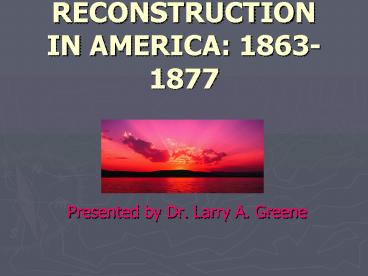RECONSTRUCTION IN AMERICA: 18631877 - PowerPoint PPT Presentation
1 / 19
Title:
RECONSTRUCTION IN AMERICA: 18631877
Description:
WHY IMPEACHMENT OF JOHNSON: TECHNICALITIES & REALITIES? ... Impact of impeachment on the office of the presidency and congress. ... – PowerPoint PPT presentation
Number of Views:52
Avg rating:3.0/5.0
Title: RECONSTRUCTION IN AMERICA: 18631877
1
RECONSTRUCTION IN AMERICA 1863-1877
- Presented by Dr. Larry A. Greene
2
INTRODUCTION
- Several Leading Actors in the Reconstruction
Historical Drama - Planter class
- Freedmen
- Northern migrants to the South
- Southern white yeoman farmer class
3
THE SETTING POSTWAR SOUTH
- Economic cost of the war to the South
- Farm animals lost
- Cities, railroads, and ports damaged
- Emancipation reduced southern agricultural
productivity - Human cost of the war South North
- Confederate dead 200,000 plus
- Union dead 300,000 plus
- Psychological impact of the war
4
PLANTERS GOALS
- Retain control of the land-prevent land
redistribution - Control a source of cheap agricultural labor
- Retain the planter monopoly on political power
- Establish the antebellum status quo as much as
possible in the new era
5
FREEDMENS GOALS
- Land
- Citizenship
- Voting rights
- Education
6
GOALS OF NORTHERN MIGRANTS TO THE SOUTH
- Carpetbagger Myth and Reality
- Northern Migrants Union soldiers White
missionaries and teachers Black missionaries and
teachers Freedmens Bureau agents Businessmen - Goals Educate the Freedmen Religious education
and establish churches for Freedmen Acquire
wealth
7
SOUTHERN WHITE YEOMAN FARMER GOALS
- Retain farm and expand farm land
- Expand economic opportunities
- Greater political participation
- Expand educational opportunities, but not
integrated education - Maintain caste and class superiority to newly
emancipated Freedmen
8
LINCOLNS RECONSTRUCTION PLAN
- Ten percent of southern voters take loyalty oath
- Constitutional Convention
- Apply for readmission to U.S.
- Lack of provision for freedmen voting.
9
ANDREW JOHNSONS RECONSTRUCTION PLAN
- Amnesty for those taking loyalty oath to the U.S.
exclusive of those whose taxable property was
more than 20,000. - President appoint a provisional governor who
would call a state convention with participation
limited to 1860 voters.
10
ANDREW JOHNSONS RECONSTRUCTION PLAN
- Election of state legislature, governor, and
congressmen. - State government must proclaim ordinances of
secession illegal, repudiate Confederate debt,
and ratify the 13th amendment. - Lack of any provision for citizenship or voting
rights for the freedmen.
11
OPPONENTS OF JOHNSONS RECONSTRUCTION PLANS
- Former Confederate states no longer part of the
U.S. Secession was state suicide. The South are
conquered provinces. - South unrepentant. Ex-Confederate high officials
responsible for secession elected under Johnsons
plan of Reconstruction.
12
OPPOSITION TO JOHNSONS RECONSTRUCTION PLANS WHY?
- Johnson pardons nearly 13,000 former Confederate
civilian and military officers excluded by his
own plan. - Freedmens Bureau extension bill vetoed.
- Anti-black violence in the South.
- Civil Rights bill of 1866 vetoed.
- Johnson opposed the 14th Amendment.
- Black Codes
13
CONGRESSIONAL RECONSTRUCTION
- 1866 Congressional campaign Failure of Johnsons
Swing around the circle campaign leads to a
more radical Congress. - Congress passes 14th amendment in 1866.
- In 1867, Congress passes the Reconstruction Act
which enables the Freedmen to vote and the Tenure
of Office Act. - Why did Congress take these aggressive actions?
- Political expediency or moral consciousness.
14
WHY IMPEACHMENT OF JOHNSON TECHNICALITIES
REALITIES?
- Violations of the Tenure of the Office Act and
Command of the Army Act? - Obstruction of the Reconstruction Act of 1867?
- Political expediency or witch-hunt?
- Fundamental ideological differences in a vision
of the reconstructed South. - Impact of impeachment on the office of the
presidency and congress.
15
CONGRESSIONALLY RECONSTRUCTED STATES
- Republican control of state governments.
- Entrance of African Americans into the political
life of the South (nearly 2,000 held local,
state, and federal office). - Accomplishments of the congressionally
reconstructed governments public education
system began and expanded infrastructure repaired.
16
OPPOSITION TO CONGRESSIONAL RECONSTRUCTION
- Formation of the Ku Klux Klan in Pulaski,
Tennessee in 1866. - Intimidation of African American elected
officials and office holders. Approximately 10
or 156 of the nearly 1,500 office holders on
which there is biographical data were attacked
and 32 actually murdered. - Congressional response with the 15th Amendment.
- Congressional and presidential response 1871 (1)
Enforcement Act (2) KU Klux Klan Act. - Reemergence of southern white paramilitary groups
of ex-Confederate soldiers in the form of new
organizations like the White Leagues and Rifle
Clubs.
17
REDEMPTION COUNTER- RECONSTRUCTION
- Presidential retreat from Reconstruction.
- Grants non-reaction to violence in Mississippi
elections of 1875 sets a pattern. - Judicial retreat from Reconstruction.
- 1873 Slaughterhouse cases
- 1876 U.S. v. Reese
- 1876 U.S. v. Cruikshank
- 1883 Civil Rights Cases
18
COUNTER-RECONSTRUCTION
- Legislative Retreat-Amnesty Act
- Disputed Election of 1876 Rutherford B. Hayes
(R) v. Samuel J. Tilden (D). - Hayes (4,036,572) Tilden (4,284,020) pop.vote
- Neither 51 majority in electoral votes
- 15 man Electoral Commission established to
recommend the apportionment of the votes in the
disputed states of S.C., LA., and Florida. - Commission recommendation Hayes (185) Tilden
(184) electoral votes
19
REUNION AND REACTION THE COMPROMISE OF 1877
- Entering the New Year without a president-elect.
Democrats threaten filibuster on Electoral
Commission recommendations - Compromise of 1877Reunion and Liberation or
Abandonment and Repression? - Federal troops pull out of the South and race
relations left to the South. - Southerners received federal patronage,
especially a cabinet appointee. - Federal subsidy for southern transcontinental
railroad































